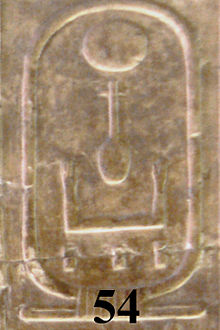Neferkaure
| Neferkaure | ||||||||||||||||||||||||||||||||||||||||||||
|---|---|---|---|---|---|---|---|---|---|---|---|---|---|---|---|---|---|---|---|---|---|---|---|---|---|---|---|---|---|---|---|---|---|---|---|---|---|---|---|---|---|---|---|---|
| Neferkawre, Kha[bau?] | ||||||||||||||||||||||||||||||||||||||||||||
 The cartouche of Neferkaure on the Abydos King List. | ||||||||||||||||||||||||||||||||||||||||||||
| Pharaoh | ||||||||||||||||||||||||||||||||||||||||||||
| Reign | 4 years and 2 months, c. 2160 BC | |||||||||||||||||||||||||||||||||||||||||||
| Predecessor | Qakare Ibi | |||||||||||||||||||||||||||||||||||||||||||
| Successor | Neferkauhor | |||||||||||||||||||||||||||||||||||||||||||
| ||||||||||||||||||||||||||||||||||||||||||||
| Dynasty | Eighth Dynasty | |||||||||||||||||||||||||||||||||||||||||||
Neferkaure was a
Attestations
Neferkaure is named on the 54th entry of the
Neferkaure is also known from a contemporary inscription, a fragmentary decree inscribed on a limestone slab known as Coptos Decree h and concerning offerings for the temple of Min at Coptos.[4] One of the two existing fragments of this decree was given by Edward Harkness to the Metropolitan Museum of Art, where it is now on display in Gallery 103.[7] The decree is dated to the fourth regnal year of Neferkaure, which is the highest attested date of any king of the Eighth Dynasty.[8] The first sign of the king's Horus name is clearly present while the second sign is debated. von Beckerath commits only to the first sign and reads Kha[...], while Baker and William C. Hayes read Khabau.[2][4][8] The decree is addressed to the then governor of Upper Egypt, Shemay, and requires that fixed amounts of offerings be given at regular intervals to the god Min and then possibly to a statue of the king.[8]
References
- ^ a b Kim Ryholt: The Late Old Kingdom in the Turin King-list and the Identity of Nitocris, Zeitschrift für ägyptische, 127, 2000, p. 99
- ^ ISBN 3-422-00832-2, p. 59, 187.
- ISBN 3-491-96053-3, p. 174.
- ^ ISBN 978-1-905299-37-9, 2008, p. 272-273
- ISBN 978-0192804587
- ^ Jürgen von Beckerath: The Date of the End of the Old Kingdom of Egypt, JNES 21 (1962), p.143
- ^ The decree on the catalog of the MET
- ^ a b c William C. Hayes: The Scepter of Egypt: A Background for the Study of the Egyptian Antiquities in The Metropolitan Museum of Art. Vol. 1, From the Earliest Times to the End of the Middle Kingdom , MetPublications, 1978, pp.136-138, available online

